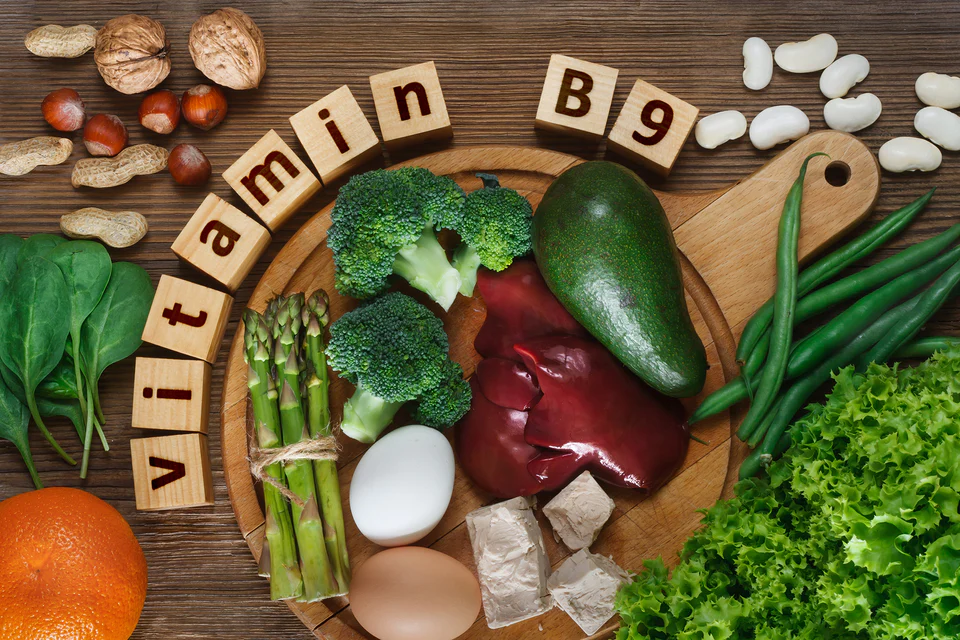B9 Or Folic Acid – This book covers the entire syllabus of “Nutrition and Dietetics” prescribed by BNMC-for all Diploma in Nursing Science and Midwifery students. We tried to accommodate latest information and topics. This book is examination friendly setup according to the teachers’ lectures and examination’s questions. At the end of the book previous university questions are given. We hope in touch with the book students’ knowledge will be upgraded and flourished. The unique way of presentation may make your reading of the book a pleasurable experience.

B9 Or Folic Acid
The recommended name is folate. Alternative name is Folacin. The usual pharmaceutical preparation is folic acid. Folic acid occurs in food in two forms: free folates and bound folates. It was found effective in curing tropical Macrocytic anaemia in human beings. The pure form of folic acid is pteroylglutamic acid (PGA). The folate acid is heat-labile and cooking partly destroys the vitamins.
Sources of Folate:
The name comes from Latin word folia, means leaf. All leafy vegetables are good dietary sources of folate.
- Animal sources: Liver, meat, dairy products, eggs, milk.
- Plant sources: Leafy vegetables, cereals and fruits
Over cooking destroys much of folic acid and this contributes to folate deficiency in manuper
Functions of Folate:
1. Folic acid plays a role in the synthesis of the nucleic acids (Which constitute the chromosomes).
2. It is also needed for the normal development of blood cells in the bone marrow.
3. It is also essential for the maturation of red blood cells.
4. Folic acid is required for DNA synthesis and cell growth and energy production as well as the forming of amino acids.
5. Folic acid is crucial for oxygen transport.
6. It is important for healthy cell division and replication.
7. It is also required for protein metabolism and in treating folic acid anemia.
8. This may be effective in treating depression and anxiety.
9. It is required for the synthesis of thiamine.
10. It serves as a mediator in metabolic reactions involving the transfer of one-carbon radicals’
11. It helps to develop of the nervous system of a developing fetus.
(Ref: Sheilla John’s/1/81)

Effects of Folate Deficiency:
Folate deficiency commonly found in pregnancy and lactation, where requirements are increased. It It results in-
1. Megaloblastic anaemia
2. Glossitis.
3. Cheilosis.
4. GIT disturbances, e.g., diarrhea, distension and flatulence’
5. Infertility or sterility (due to severe deficiency).
6. May produce abortions or congenital malformations (In early pregnancy).
(Ref: T. K. Indrani/1″/90)
Daily requirement of folic acid:
| Person | Requirement per day |
| Healthy adult | 100 mg |
| Pregnancy | 300 mg |
| Lactation | 150 mg |
| Children | 100 mg |
(Ref: T. K. Indrani/1/90)

Confirmatory Diagnosis of Folic-Acid Deficiency:
Though the anemia of folic-acid deficiency is indistinguishable from the megaloblastic anaemia of vitamin B12 deficiency, it will respond to the trial therapy with folic-acid only. Estimation of serum level (normal range being 6 to 20 ng, i.e. nanogram per 100 ml) will accurately establish the diagnosis. When the level is less than 3 mg per cent it is absolutely sure. When it is found just below 6 mg per cent it is most likely.
(Ref: Essential of Human Nutrition/1/89)
Read more:
